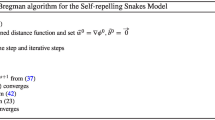Abstract
This paper presents a termination criterion for active contour that does not involve alteration of the energy functional. The criterion is based on the area difference of the contour during evolution. In this criterion, the evolution of the contour terminates when the area difference fluctuates around a constant. The termination criterion is tested using parametric gradient vector flow active contour with contour resampling and normal force selection. The usefulness of the criterion is shown through its trend, speed, accuracy, shape insensitivity, and insensitivity to contour resampling. The metric used in the proposed criterion demonstrated a steadily decreasing trend. For automatic implementation in which different shapes need to be segmented, the proposed criterion demonstrated almost 50% and 60% total time reduction while achieving similar accuracy as compared with the pixel movement-based method in the segmentation of synthetic and real medical images, respectively. Our results also show that the proposed termination criterion is insensitive to shape variation and contour resampling. The criterion also possesses potential to be used for other kinds of snakes.






Similar content being viewed by others
References
Kass M, Witkin A, Terzopoulos D: Snakes: Active contour models. International Journal of Computer Vision 1:321–331, 1988
Horritt MS, Mason DC, Luckman AJ: Flood boundary delineation from synthetic aperture radar imagery using a statistical active contour model. International Journal of Remote Sensing 22:2489–2507, 2001
Jiang H, Cheng Q: Automatic 3D segmentation of CT images based on active contour models. Proceedings of the 11th IEEE International Conference on Computer-Aided Design and Computer Graphics: City
Jurcak V, et al: Automated segmentation of the quadratus lumborum muscle from magnetic resonance images using a hybrid atlas based-geodesic active contour scheme. Conference Proceedings: Annual International Conference of the IEEE EMBS 2008:867–870, 2008
Liu B, Cheng HD, Huang J, Tian J, Liu J, Tang X: Automated segmentation of ultrasonic breast lesions using statistical texture classification and active contour based on probability distance. Ultrasound in Medicine and Biology 35:1309–1324, 2009
Chan TF, Vese LA: Active contours without edges. IEEE Transactions on Image Processing 10:266–277, 2001
Acton ST, Ray N: Algorithm KWT: Morgan & Claypool Publishers, 2009
Chen Y, Zhao W, Wang Z: Level set segmentation algorithm based on image entropy and simulated annealing. Proc. ICBBE: City
Lee SH, Seo JK: Level set-based bimodal segmentation with stationary global minimum. IEEE Transactions on Image Processing 15:2843–2852, 2006
Ray N, Chanda B, Das J: A fast and flexible multiresolution snake with a definite termination criterion. Pattern Recognition 34:1483–1490, 2001
Shuai Y, Sun H, Xu G: SAR image segmentation based on level set with stationary global minimum. IEEE Geoscience and Remote Sensing Letters 5:644–648, 2008
Wang XF, Huang DS, Xu H: An efficient local Chan–Vese model for image segmentation. Pattern Recognition 43:603–618, 2010
Liu J, Gao W, Huang S, Nowinski WL: A model-based, semi-global segmentation approach for automatic 3-D point landmark localization in neuroimages. IEEE Transactions on Medical Imaging 27:1034–1044, 2008
Lobregt S, Viergever MA: Discrete dynamic contour model. IEEE Transactions on Medical Imaging 14:12–24, 1995
Xu C, Prince JL: Snakes, shapes, and gradient vector flow. IEEE Transactions on Image Processing 7:359–369, 1998
Dong X, Zheng G: Automatic extraction of proximal femur contours from calibrated X-ray images using 3D statistical models: An in vitro study. International Journal of Medical Robotics and Computer Assisted Surgery 5:213–222, 2009
Baldwin MA, Langenderfer JE, Rullkoetter PJ, Laz PJ: Development of subject-specific and statistical shape models of the knee using an efficient segmentation and mesh-morphing approach. Computer Methods and Programs in Biomedicine 97:232–240, 2010
Von Jan U, Sandkühler D, Kirsch L, Rühmann U, Overhoff HM: Surgical planning for the humeral part of a shoulder endoprosthesis based on landmarks determined from 3D ultrasound volumes. International Journal of Computer Assisted Radiology and Surgery 1:229–231, 2006
Otsu N: Threshold selection method from gray-level histograms. IEEE Trans Syst Man Cybern SMC 9:62–66, 1979
Lam L, Lee S-W, Suen CY: Thinning methodologies—A comprehensive survey. IEEE Transactions on Pattern Analysis and Machine Intelligence 14:page 879, bottom of first column through top of second column, 1992
Fripp J, Crozier S, Warfield SK, Ourselin S: Automatic segmentation of the bone and extraction of the bone–cartilage interface from magnetic resonance images of the knee. Physics in Medicine and Biology 52:1617–1631, 2007
Cohen LD: On active contour models and balloons. CVGIP: Image Understanding 53:211–218, 1991
Jehan-Besson S, Gastaud M, Barlaud M, Aubert G: Region-based active contours using geometrical and statistical features for image segmentation. Proceedings of the IEEE International Conference on Image Processing: City
Acknowledgments
T. K. Chuah would like to express his gratitude to the university for providing financial support through Nanyang President Graduate Scholarship. The authors thank the Ministry of Education (MOE), Singapore, for supporting the project through SUG09/07 and AcRF Tier 1 (RG34/07) grant.
Author information
Authors and Affiliations
Corresponding author
Rights and permissions
About this article
Cite this article
Chuah, T.K., Lim, J.H. & Poh, C.L. Group Average Difference: A Termination Criterion for Active Contour. J Digit Imaging 25, 279–293 (2012). https://doi.org/10.1007/s10278-011-9405-y
Published:
Issue Date:
DOI: https://doi.org/10.1007/s10278-011-9405-y




